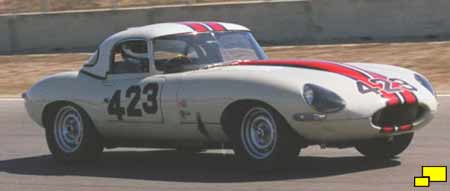
|
|
|
|
Jaguar E-Type Racing
|
|
As a race car, the Jaguar E-Type achieved only limited success. Part of the reason is the high level of competition in the 1960s. Ford had a high dollar factory effort and then there were those unbeatable Ferrari GTOs. By then the world had discovered the advantages of the mid-engine layout. Since the E-type was a front engine design, it was at a disadvantage.
It's not that there was a big need for Jaguar to race the E-Type. They were flush with the recent success at Le Mans only a few years earlier which the public had not forgotten. Why spend the money when there was no need? Besides, they had a car that would get speeding tickets when parked.
|
|

|
|
1963 Lightweight E-Type racer, at speed in the Monterey historic races at Laguna Seca in August 1999. It had been raced only two other times, with Ed Leslie and Frank Morrill driving it to a class win in 1963 at Sebring and then at the same Laguna Seca racetrack with Ed Leslie driving. It was stored for 35 years in a garage (one of those stories) and was auctioned off at the Monterey Sports Car Auction in August 1998. In a brilliant move, the sellers put it on the auction block in the exact condition it was found; no attempt was made to clean it, so the 35 years of dirt was still present when it sold. The final price was $875,050. The car was restored by Lynx Motors. Click here and here for a video. Note the use of solid as opposed to wire wheels. They might not have that touch of class but they are stronger, an important consideration for racing.
|
|
|

Cutaway drawing is courtesy Shin Yoshikawa.
Click on the drawing for more details.
|
|
|
The factory did not ignore racing and produced a series of 12 cars known as the E-Type Lightweights, so called because of the use of exotic materials and other steps taken to reduce weight. For more information on the Lightweights, visit the Mike Builds a Lightweight site.
|

|

|
Lightweight Jaguar E-Type on display. Note the separate welded hood louvers, similar to the construction of the early (approximately first 100) E-types. Visible in the enlargement is the external bonnet latch, also found on the earliest production E-types. Since the entire bonnet lifted, engine access is excellent on all E-types.
Photographs courtesy Andrew Fearon.
|
|
|
|
|
|
|
Jaguar E-Type Forum
Contact other enthusiasts with Jaguar E-Type questions, comments and advice!
Click here to visit the WebCars! Jaguar E-Type Forum.
|
|
|
Note: Clicking on an image with this symbol ( ) will lead to a larger image. ) will lead to a larger image.
(A new window will open in your browser)
|

Suggestions? Comments? Tell us!!!
|

|
|






